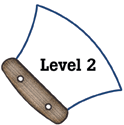
Alaska Science
Key Element B2
A student who meets the content standard should design and conduct scientific investigations using appropriate instruments.
 |
Alaska Science A student who meets the content standard should design and conduct scientific investigations using appropriate instruments. |
|
Performance Standard Level 2, Ages 8–10
|
|
|
|
Sample Assessment Ideas
|
|
|
Expanded Sample Assessment Idea
|
|
Procedure Students will:
Reflection and Revision
|
Levels of Performance |
||
|
Stage 4 |
Student work is complete, correct, and shows evidence of elaboration, extension, and mastery of drawing inferences based on experimental data. The investigation has a testable question, makes a prediction, lists variables, controls the variables when possible, manipulates a single variable, makes accurate measurements, records results, and makes appropriate conclusions. | ||
|
Stage 3
|
Student work is complete but shows limited evidence of elaboration, extension and ability to draw inferences based on experimental data. The investigation includes a testable question, makes a prediction, lists some variables, controls most (but not all) variables, manipulates a single variable, makes measurements that are mostly accurate, and records results but makes inappropriate conclusions. | ||
|
Stage 2
|
Student work may be incomplete or incorrect and shows limited evidence of understanding variables and how to manipulate them. The investigation may ask a testable question and make a prediction. However, the results are inaccurate or incomplete and the conclusions if present, does not relate to or reflect the experimental data. | ||
|
Stage 1
|
Student work is incomplete and incorrect. Although the investigation may consider questions about plant growth, it lacks an experimental procedure that reflects variables, controls, data collection or data manipulation. | ||
Standards Cross-References
|
||
|
National Science Education Standards Plan and conduct a simple investigation. In the earliest years, investigations are largely based on systematic observations. As students develop, they may design and conduct simple experiments to answer questions. The idea of a fair test is possible for many students to consider by fourth grade. (Page 122) Scientists use different kinds of investigations depending on the questions they are trying to answer. Types of investigations include describing objects, events, and organisms; classifying them; and doing a fair test (experimenting). (Page 123) Different kinds of questions suggest different kinds of scientific investigations. Some investigations involve observing and describing objects, organisms, or events; some involve collecting specimens; some involve experiments; some involve seeking more information; some involve discovery of new objects and phenomena; and some involve making models. (Page 148) Scientific investigations sometimes result in new ideas and phenomena for study, generate new methods or procedures for an investigation, or develop new technologies to improve the collection of data. All of these results can lead to new investigations. (Page 148) |
Benchmarks Results of similar scientific investigations seldom turn out exactly the same. Sometimes this is because of unexpected differences in the things being investigated, sometimes because of unrealized differences in the methods used or in the circumstances in which the investigation is carried out, and sometimes just because of uncertainties in observations. It is not always easy to tell which. (Page 6) Scientific investigations may take many different forms, including observing what things are like or what is happening somewhere, collecting specimens for analysis, and doing experiments. Investigations can focus on physical, biological, or social questions. (Page 11) Seek better reasons for believing something other than “Everybody knows that . . . ” or “I just know” and discount such reasons when given by others. (Page 299) |
|
Table of Contents | Return to Alaska Native Knowledge Network